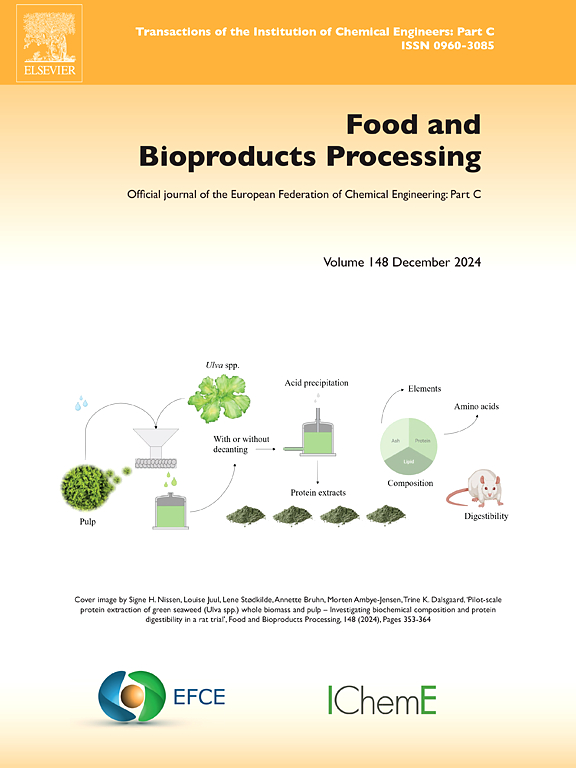Enhancing the antioxidant and barrier properties of carboxymethyl chitosan/polyvinyl alcohol films by incorporating pomelo seed extract nano-emulsion
IF 3.4
2区 农林科学
Q2 BIOTECHNOLOGY & APPLIED MICROBIOLOGY
引用次数: 0
Abstract
In this research, the oil and alcohol phases were extracted from pomelo seeds and used to prepare nano-emulsions with whey protein (WP). Four bioactive films were developed by incorporating varying concentrations of pomelo seed extract nano-emulsions (PSE-NE) into carboxymethyl chitosan (CMCS)/polyvinyl alcohol (PVA) matrices. The preparation process of the nano-emulsion was investigated, and its microstructure was characterized via transmission electron microscopy (TEM). The interactions between the nano-emulsion and the film matrix were investigated through characterization via scanning electron microscopy (SEM), fourier-transform infrared spectroscopy (FTIR), X-ray diffraction (XRD), and thermogravimetric analysis (TGA). Moreover, the physical properties and bioactivity of the films, such as mechanical properties, antioxidant activity, water vapor transmission rate (WVTR), UV-Vis light-blocking performance, and biodegradability were studied. The results identified CPP-3 film as the optimal film formulation, exhibiting strong antioxidant capacity with DPPH and ABTS radical scavenging rates of 87.66 ± 0.40 % and 92.25 ± 0.95 %, respectively. It demonstrated a water vapor transmission rate of 6.74 ± 1.04 g/m2/h, an opacity coefficient of 2.96 mm−1, and a biodegradation rate of 56.51 ± 0.48 % after 25 days of soil burial. These findings highlight the promise of biodegradable films based on PSE-NE for environmentally friendly food packaging applications, providing a new way for valorizing plant-derived waste such as pomelo seeds in eco-friendly packaging solutions.
柚籽提取物纳米乳液增强羧甲基壳聚糖/聚乙烯醇膜的抗氧化和屏障性能
本研究从柚籽中提取油相和醇相,制备乳清蛋白纳米乳液。将不同浓度的柚籽提取物纳米乳液(PSE-NE)加入羧甲基壳聚糖(CMCS)/聚乙烯醇(PVA)基质中,制备了四种生物活性膜。研究了纳米乳液的制备工艺,并用透射电镜(TEM)对其微观结构进行了表征。通过扫描电镜(SEM)、傅里叶变换红外光谱(FTIR)、x射线衍射(XRD)和热重分析(TGA)表征纳米乳液与膜基质之间的相互作用。此外,还研究了膜的物理性能和生物活性,如机械性能、抗氧化性能、水蒸气透过率(WVTR)、UV-Vis阻光性能和生物降解性。结果表明,CPP-3膜具有较强的抗氧化能力,对DPPH和ABTS自由基的清除率分别为87.66±0.40 %和92.25±0.95 %。土壤埋藏25 d后,其水蒸气透过率为6.74 ± 1.04 g/m2/h,不透明度系数为2.96 mm−1,生物降解率为56.51 ± 0.48 %。这些发现突出了基于PSE-NE的可生物降解薄膜在环保食品包装应用中的前景,为在环保包装解决方案中对柚子种子等植物来源的废物进行评估提供了一种新的方法。
本文章由计算机程序翻译,如有差异,请以英文原文为准。
求助全文
约1分钟内获得全文
求助全文
来源期刊

Food and Bioproducts Processing
工程技术-工程:化工
CiteScore
9.70
自引率
4.30%
发文量
115
审稿时长
24 days
期刊介绍:
Official Journal of the European Federation of Chemical Engineering:
Part C
FBP aims to be the principal international journal for publication of high quality, original papers in the branches of engineering and science dedicated to the safe processing of biological products. It is the only journal to exploit the synergy between biotechnology, bioprocessing and food engineering.
Papers showing how research results can be used in engineering design, and accounts of experimental or theoretical research work bringing new perspectives to established principles, highlighting unsolved problems or indicating directions for future research, are particularly welcome. Contributions that deal with new developments in equipment or processes and that can be given quantitative expression are encouraged. The journal is especially interested in papers that extend the boundaries of food and bioproducts processing.
The journal has a strong emphasis on the interface between engineering and food or bioproducts. Papers that are not likely to be published are those:
• Primarily concerned with food formulation
• That use experimental design techniques to obtain response surfaces but gain little insight from them
• That are empirical and ignore established mechanistic models, e.g., empirical drying curves
• That are primarily concerned about sensory evaluation and colour
• Concern the extraction, encapsulation and/or antioxidant activity of a specific biological material without providing insight that could be applied to a similar but different material,
• Containing only chemical analyses of biological materials.
 求助内容:
求助内容: 应助结果提醒方式:
应助结果提醒方式:


